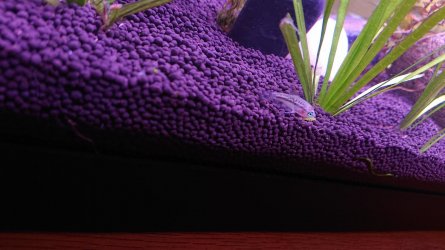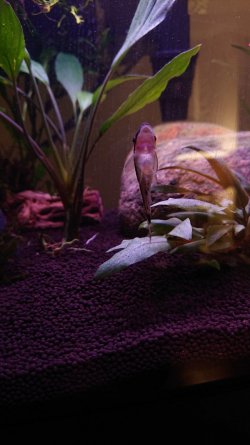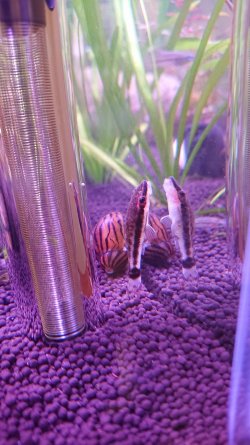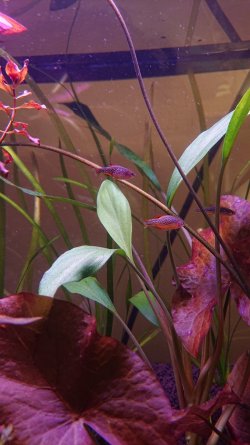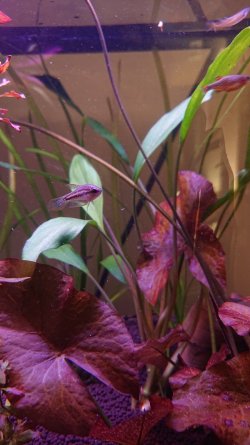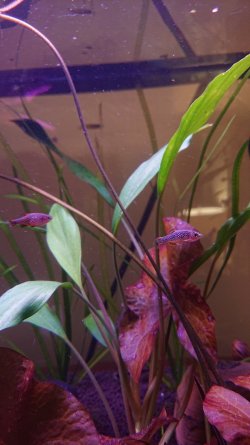Hi everyone,
Long time no see! If anyone is around to help me with issues in my 20g long, I would greatly appreciate it. Problem in short: since 2 days ago, fish (Sparkling Gourami and maybe others) hover over gravel and then die the next day, no other symptoms.
Tank size: 20g long
tank age: 4 months
pH: 6.2
ammonia: 0
nitrite: 0
nitrate: 10
kH: 10
gH: 150
tank temp: 75
Fish Symptoms (include full description including lesion, color, location, fish behavior): I see the sparkling Gouramis getting pale and hover on the bottom. They don't lie on the side but sort of lie upright. They try to get up for food, swimming slowly, weakly and disoriented toward the surface and then sink down again. Are dead the next morning. Were doing fine for 3 months. Lost two so far.
Volume and Frequency of water changes: Normal schedule is 25% biweekly. Have been doing 25% daily for the last 3 days, since Gouramis started showing symptoms.
Chemical Additives or Media in your tank: Planted tank with Ada Aquasoil (hence the low pH), adding The 2h Aquarist zero plant food as written on the bottle every 2 days. API stress coat for water changes.
Tank inhabitants: 5x sparkling gourami, 3x pseudomugil getrudae, 3x celestial pearl danio, 3x otocinclus vittatus, 2x nerite snail
Recent additions to your tank (living or decoration): Never had a fish die before I made the new additions of 2 Badis Badis (Chameleonfish, not scarlet badis) and 5 pseudomugil gertrudae about 3 weeks ago. One getrudae had jumped out, I put him back but he didn't make it. Second one died within 2 days of arrival. Badis badis died within 4 days of arrival. Then nothing happened for two weeks - now the Sparkling Gourami start dying. Fish are introduced with drip irrigation over 1h, and no, I don't have a quarantine tank.
I thought it was obvious that the new additions brought a disease to the tank. Went to the fish store and the same batches of fish where I got mine from have been doing great for multiple weeks, alive and happy, owners told me they didn't show any signs of disease.
I had a school of 8 Danio choprae that I switched out for the Badis and Gertrudae, so there was no significant increase in bioload.
I noticed that KH was low and was concerned about ammonia spikes and PH swings. Tested the water daily and never saw any. Still got Seachem Alkaline and Acid buffer this week and started to add them for KH increase.
Do you guys have any thoughts? Would really love to save these Gouramis that I had for several months. Thanks so much in advance!
Hedgely
Long time no see! If anyone is around to help me with issues in my 20g long, I would greatly appreciate it. Problem in short: since 2 days ago, fish (Sparkling Gourami and maybe others) hover over gravel and then die the next day, no other symptoms.
Tank size: 20g long
tank age: 4 months
pH: 6.2
ammonia: 0
nitrite: 0
nitrate: 10
kH: 10
gH: 150
tank temp: 75
Fish Symptoms (include full description including lesion, color, location, fish behavior): I see the sparkling Gouramis getting pale and hover on the bottom. They don't lie on the side but sort of lie upright. They try to get up for food, swimming slowly, weakly and disoriented toward the surface and then sink down again. Are dead the next morning. Were doing fine for 3 months. Lost two so far.
Volume and Frequency of water changes: Normal schedule is 25% biweekly. Have been doing 25% daily for the last 3 days, since Gouramis started showing symptoms.
Chemical Additives or Media in your tank: Planted tank with Ada Aquasoil (hence the low pH), adding The 2h Aquarist zero plant food as written on the bottle every 2 days. API stress coat for water changes.
Tank inhabitants: 5x sparkling gourami, 3x pseudomugil getrudae, 3x celestial pearl danio, 3x otocinclus vittatus, 2x nerite snail
Recent additions to your tank (living or decoration): Never had a fish die before I made the new additions of 2 Badis Badis (Chameleonfish, not scarlet badis) and 5 pseudomugil gertrudae about 3 weeks ago. One getrudae had jumped out, I put him back but he didn't make it. Second one died within 2 days of arrival. Badis badis died within 4 days of arrival. Then nothing happened for two weeks - now the Sparkling Gourami start dying. Fish are introduced with drip irrigation over 1h, and no, I don't have a quarantine tank.
I thought it was obvious that the new additions brought a disease to the tank. Went to the fish store and the same batches of fish where I got mine from have been doing great for multiple weeks, alive and happy, owners told me they didn't show any signs of disease.
I had a school of 8 Danio choprae that I switched out for the Badis and Gertrudae, so there was no significant increase in bioload.
I noticed that KH was low and was concerned about ammonia spikes and PH swings. Tested the water daily and never saw any. Still got Seachem Alkaline and Acid buffer this week and started to add them for KH increase.
Do you guys have any thoughts? Would really love to save these Gouramis that I had for several months. Thanks so much in advance!
Hedgely

